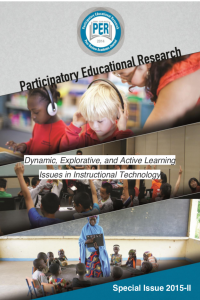Abstract
References
- Crookall, D., & Oxford, R. L. (Eds.). (1990). Simulation, gaming, and language learning. New York: Newbury House.
- JALT "95: Curriculum and Evaluation. (1996). Tokyo: The Japan Association for Language Teaching, pp. 313-317. Copyright @ Randall S. Davis. Retrieved from: http://www.esl-lab.com/research/simul.htm
- Jones, K. (1982). Simulations in language teaching. Cambridge: Cambridge University Press.
- Nurullin R.A. Education system as reflection of culture and civilization Нуруллин Р.А. Система образования как отражение культуры и цивилизации. Retrieved from: http://vml.antat.ru/files/4e%20Chteniya/Sistema%20obrazovaniya%20kak%20otrajenie%20kultury%20i%20civilizacii.pdf
- Open Education Consortium. Retrieved from: http://www.oeconsortium.org/about-oec/
- Shchelkunov M.D., & Nikolaeva E.M. Education in XXI century: facing new challenges (2010) Щелкунов М.Д. Николаева, Е.М. Образование в ХХI веке: перед лицом новых вызовов, -Казань: Казан. гос. ун-т. -pp. 94-107, 156p.
Abstract
The paper is devoted to the phenomena of open education and describes the experience of large-scale simulation for encouraging the faculty members and students of a higher educational institution to learn academic English and to apply their language knowledge and ability in the quasi-real situation. Since 2010, five conferences were held on the main theme “Information systems and technologies in science and life” in the English language. Each time from eight to ten reports were introduced followed by discussions. Three main competencies that are in demand in almost all modern education systems and in global science – language ability, ability to deal with information, and knowledge in a certain field – were activated. To make a sense of using English, some foreign participants, face-to-face and online, were invited to the conference. The number of participants from the educational institution was eight speakers each conference. Simulation is obeyed a rigorous scenario. To achieve the aim successfully a participant should act in a certain and correct way. The idea of such simulation activities comply with the principles of the open education: person-oriented character, practical orientation of content and joint activities, problematic content and conversational character of interaction in the training process, reflexivity, variability and supporting motivation approach
References
- Crookall, D., & Oxford, R. L. (Eds.). (1990). Simulation, gaming, and language learning. New York: Newbury House.
- JALT "95: Curriculum and Evaluation. (1996). Tokyo: The Japan Association for Language Teaching, pp. 313-317. Copyright @ Randall S. Davis. Retrieved from: http://www.esl-lab.com/research/simul.htm
- Jones, K. (1982). Simulations in language teaching. Cambridge: Cambridge University Press.
- Nurullin R.A. Education system as reflection of culture and civilization Нуруллин Р.А. Система образования как отражение культуры и цивилизации. Retrieved from: http://vml.antat.ru/files/4e%20Chteniya/Sistema%20obrazovaniya%20kak%20otrajenie%20kultury%20i%20civilizacii.pdf
- Open Education Consortium. Retrieved from: http://www.oeconsortium.org/about-oec/
- Shchelkunov M.D., & Nikolaeva E.M. Education in XXI century: facing new challenges (2010) Щелкунов М.Д. Николаева, Е.М. Образование в ХХI веке: перед лицом новых вызовов, -Казань: Казан. гос. ун-т. -pp. 94-107, 156p.
Details
| Primary Language | English |
|---|---|
| Subjects | Studies on Education |
| Journal Section | Research Articles |
| Authors | |
| Publication Date | December 1, 2015 |
| Acceptance Date | October 30, 2015 |
| Published in Issue | Year 2015 Special Issue 2015 II |


